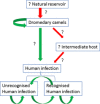Dromedary Camels and the Transmission of Middle East Respiratory Syndrome Coronavirus (MERS-CoV)
- PMID: 26256102
- PMCID: PMC4749478
- DOI: 10.1111/tbed.12401
Dromedary Camels and the Transmission of Middle East Respiratory Syndrome Coronavirus (MERS-CoV)
Abstract
Middle East respiratory syndrome coronavirus (MERS-CoV) is an existential threat to global public health. The virus has been repeatedly detected in dromedary camels (Camelus dromedarius). Adult animals in many countries in the Middle East as well as in North and East Africa showed high (>90%) seroprevalence to the virus. Middle East respiratory syndrome coronavirus isolated from dromedaries is genetically and phenotypically similar to viruses from humans. We summarize current understanding of the ecology of MERS-CoV in animals and transmission at the animal-human interface. We review aspects of husbandry, animal movements and trade and the use and consumption of camel dairy and meat products in the Middle East that may be relevant to the epidemiology of MERS. We also highlight the gaps in understanding the transmission of this virus in animals and from animals to humans.
Keywords: MERS-CoV; coronavirus; dromedary camels; human; transmission; zoonosis.
© 2015 Blackwell Verlag GmbH.
Conflict of interest statement
The authors declare no conflict of interest.
Figures




Similar articles
-
[Dromedary camels and Middle East respiratory syndrome: MERS coronavirus in the 'ship of the desert'].Ned Tijdschr Geneeskd. 2014;158:A7806. Ned Tijdschr Geneeskd. 2014. PMID: 25248734 Review. Dutch.
-
Middle East Respiratory Syndrome Coronavirus (MERS-CoV) in Dromedary Camels in Africa and Middle East.Viruses. 2019 Aug 5;11(8):717. doi: 10.3390/v11080717. Viruses. 2019. PMID: 31387326 Free PMC article.
-
Middle East respiratory syndrome coronavirus (MERS-CoV): animal to human interaction.Pathog Glob Health. 2015;109(8):354-62. doi: 10.1080/20477724.2015.1122852. Pathog Glob Health. 2015. PMID: 26924345 Free PMC article. Review.
-
Deciphering MERS-CoV Evolution in Dromedary Camels.Trends Microbiol. 2016 Feb;24(2):87-89. doi: 10.1016/j.tim.2015.12.013. Epub 2016 Jan 8. Trends Microbiol. 2016. PMID: 26775034 Free PMC article.
-
Middle East Respiratory Syndrome Coronavirus (MERS-CoV) origin and animal reservoir.Virol J. 2016 Jun 3;13:87. doi: 10.1186/s12985-016-0544-0. Virol J. 2016. PMID: 27255185 Free PMC article. Review.
Cited by
-
Circulation of Non-Middle East Respiratory Syndrome (MERS) Coronaviruses in Imported Camels in Saudi Arabia.Cureus. 2024 Jun 28;16(6):e63351. doi: 10.7759/cureus.63351. eCollection 2024 Jun. Cureus. 2024. PMID: 39077303 Free PMC article.
-
ROI extraction in corona virus (COVID 19) CT images using intuitionistic fuzzy edge detection.Heliyon. 2024 Mar 16;10(6):e27798. doi: 10.1016/j.heliyon.2024.e27798. eCollection 2024 Mar 30. Heliyon. 2024. PMID: 38545231 Free PMC article.
-
The effect of governance structures on optimal control of two-patch epidemic models.J Math Biol. 2023 Oct 20;87(5):74. doi: 10.1007/s00285-023-02001-8. J Math Biol. 2023. PMID: 37861753 Free PMC article.
-
Detection of Alpha- and Betacoronaviruses in Small Mammals in Western Yunnan Province, China.Viruses. 2023 Sep 20;15(9):1965. doi: 10.3390/v15091965. Viruses. 2023. PMID: 37766371 Free PMC article.
-
Extensive research into MERS-CoV to ascertain its current status, epidemiological context, and potential in the future.Int J Surg. 2023 Mar 1;109(3):242-243. doi: 10.1097/JS9.0000000000000227. Int J Surg. 2023. PMID: 36906783 Free PMC article. No abstract available.
References
-
- Abdallah, R. , and Faye B., 2013: Typology of camel farming system in Saudi Arabia. Emir. J. Food Agric. 25, 250–260.
-
- Aburizaiza, A. S. , Mattes F. M., Azhar E. I., Hassan A. M., Memish Z. A., Muth D., Meyer B., Lattwein E., Muller M. A., and Drosten C., 2014: Investigation of anti‐middle East respiratory syndrome antibodies in blood donors and slaughterhouse workers in Jeddah and Makkah, Saudi Arabia, fall 2012. J. Infect. Dis. 209, 243–246. - PMC - PubMed
-
- Alagaili, A. N. , Briese T., Mishra N., Kapoor V., Sameroff S. C., Burbelo P. D., de Wit E., Munster V. J., Hensley L. E., Zalmout I. S., Kapoor A., Epstein J. H., Karesh W. B., Daszak P., Mohammed O. B., and Lipkin W. I., 2014: Middle East respiratory syndrome coronavirus infection in dromedary camels in Saudi Arabia. MBio 5, e00884‐00814. - PMC - PubMed
Publication types
MeSH terms
Grants and funding
LinkOut - more resources
Full Text Sources
Other Literature Sources

